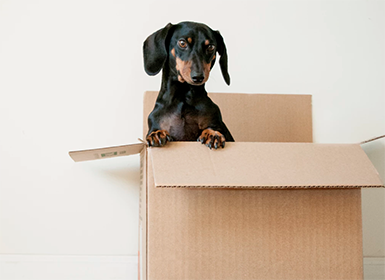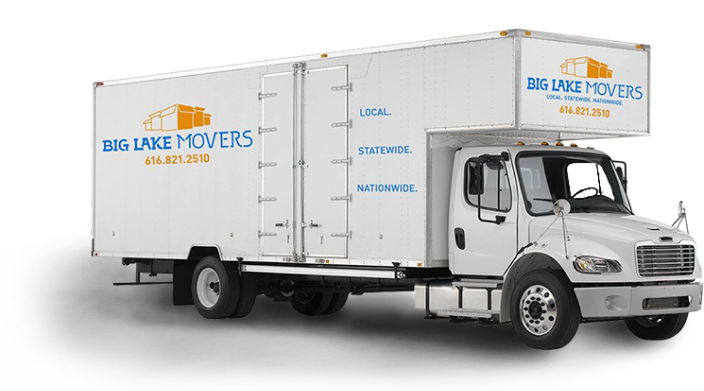
Moving is an adventure for some and an experience others dread. No matter which category you fit into, moving with pets makes it more complex and adds to the stress of the situation.
Hiring a professional moving service can help reduce the anxiousness of relocating with your furry family members. Here are a few tips for moving with pets in Michigan.
1. Make a Plan for Moving with Pets
Moving is already a complicated process, so adding pets into the mix can make it even more hectic. Like their human counterparts, cats and dogs experience high-stress levels during unknown and chaotic situations. The best way to keep them safe and minimize their anxiety is to have a plan in place for the move.
Sit down and develop a plan for how you will move your pet. It should include questions and answers like:
- How are you going to transport your pet?
- Where will your pet be before, during, and after the move?
- What will your pet’s living situation be like in the new home?
- How will your pet get exercise and meet new friends in the new neighborhood?
Your plan should be tailored to your pet’s specific needs so they can have a smooth transition from one home to another. For example, you’ll need separate strategies for young and senior animals.
Puppies and kittens require a lot of exercise and plenty of time to adjust to their new surroundings, while senior animals may need more time to adapt and may require a smaller space with fewer changes.
2. Packing With Your Pets in Mind
When you start to bring in boxes and packing materials, your pet will become curious and want to explore. That’s okay. Don’t stress them out more by trying to keep them out of the way.
Instead, create a space for them in one or two rooms and designate specific boxes that they can play with. Include a litter box and food/water dishes in their designated area if you have a cat.
When you get your pet used to having boxes and packing materials around, you can help avoid them becoming stressed out when the moving process begins.
3. Think About Their Supplies
If you’re driving to your new home, will you have room for your pet’s carrier in the car? What are the requirements for bringing a pet on the plane if you’re flying?
Choose a carrier that’s spacious enough for your pet to move around in, and pack plenty of food and water for the trip. Add a comfortable blanket, toys, and a small litter box for cats.
When moving with a pet, make sure all their supplies are packed together, such as:
- Food
- Treats
- Toys
- Blankets
- Bedding
- Litter box
- Medicine
Other tips for moving with a pet are to label all your pet’s supplies so you can find them quickly and easily.
4. Plan Where Your Pet Will Stay Between Moves
If you’re wondering how to move with a pet when it’s a long-distance move, you’re not alone. Sometimes, pets can’t just come along for the ride—they need a place to stay between moves to keep them safe while you set up their new home.
There are a few options for finding a pet-friendly place to stay.
Boarding kennels
These locations offer a safe and comfortable place for your pet to stay, but they can be expensive. However, their safety should be a top priority when you’re moving with pets. Your veterinarian might offer boarding services.
Check with them first. You and your pets might be more comfortable with care from a professional that’s also a familiar face. When boarding your cat or dog, they’ll need to be up-to-date on all their vaccinations. Plus, there are a few other shots specific to boarding, so ask your veterinarian for more information.
Friends or Family
If you have friends or family members who are pet-friendly and close to your new location, they can be an excellent option for a place to stay. Just make sure to plan ahead, as they may not be available last minute. This can be more comforting for your pet, as they will be able to stay in a familiar environment.
Pet-sitting
If you don’t want to leave your pet at a boarding kennel and you don’t have any friends or family close by, pet-sitting may be a good option. Ask your veterinarian for a referral to a reputable pet-sitting service in your new town. With this option, your pet will be able to stay in its own home and receive regular visits from a sitter.
5. Make Your New Home Pet-Friendly
One of the most important things to consider when moving with pets is whether your new home is pet-friendly. Some things to look for are:
- A designated space for your pet to stay.
- A yard that’s fenced in or a safe for dogs to go to the bathroom, get fresh air, and play.
- Dangerous areas such as pools, hot tubs, or busy streets that your pet needs to be kept away from.
- Easy access to food and water.
Also, go through the home’s interior and make sure everything is safe and sealed. Electric cords should be covered, and out of reach, poisonous plants should be removed, and any small objects that your pet could choke on should be tucked away.
It’s important to remember that not every pet will be comfortable in every new environment. Take the time to get to know your new home and see how your pet adjusts. If they’re having a hard time, speak with your veterinarian about what you can do to help them feel more comfortable.
6. Consider Moving Day
One of the most important tips for moving with a pet comes on moving day. With all the excitement and chaos, it’s easy to forget about your pet. Make sure you take time to walk and play with them, as it will help keep them calm and distracted from all the commotion.
Keep them in an enclosed space away from most of the noise and chaos. Consider putting the TV or music on to muffle the noise and keep them calm.
Next, select an area in your new home where your pet can stay while you finish unpacking. This space should be comfortable and quiet, with their food, water, and bed close by.
7. Make a Plan For the Drive or Plan
If you’re moving with a pet and driving to your new home, there are a few things to keep in mind — like safety and comfortability.
Make sure to secure their carrier or crate in the backseat of your car. This will help to keep them from being thrown around if you have to slam on the brakes.
Also, take regular breaks so they can get out and walk around. This is also a good time to give them some water and food. Don’t blast music or air conditioning at full blast, as this can be uncomfortable and unsafe for your pet.
You also need to think about a cross-country move that requires a long plane ride. You’ll need to make arrangements for your pet well in advance. The first thing you need to do is find a pet-friendly airline. There are several of them, but not all airlines allow animals on board. Not all airports are pet-friendly either, so make sure to do your research.
The next step is to purchase a pet carrier that meets the airline’s requirements. Carriers must be big enough for your pet to stand up and turn around in, and they must have a water dish and food dish attached.
Some pets are more anxious than others during moves. If yours falls into this category, you may need to speak with your veterinarian about giving them a sedative. This will help keep them calm and safe during the move.
You’ll also need to provide a health certificate from your veterinarian and proof of vaccinations. Finally, be sure to arrive at the airport early with plenty of time to check in your pet.
It’s understandable that you and your pet might be anxious about the long move. But with a little preparation, both of you will make it to your new home safe and sound.
8. Keep Them on Their Normal Diet
Moving can be a stressful time for pets. To help minimize the stress, keep them on their normal diet as much as possible. This will help to avoid any stomach upset or diarrhea.
9. Make Sure They Have Identification
Even if your pet is usually indoor-only, it’s a good idea to have them wear some form of identification during the move. This can be a collar with your current address and phone number or a microchip with up-to-date contact information.
10. Have Fun!
The best way to help your pet adjust to their new home is to make the transition fun. Take them on lots of walks and play with them as much as possible. This will help them get comfortable in their new surroundings.
Moving with a pet can be stressful, but with these tips, it can also be a smooth transition for both you and your furry friend. By following these suggestions, you can help keep your pet safe and healthy.
Contact Big Lake Movers
Here at Big Lake Movers, our professional movers are dedicated to ensuring 100 percent customer satisfaction through affordable, seamless residential moves of all sizes. Interested in learning more about our home moves? Contact us in one of our three locations or request a free quote online.




